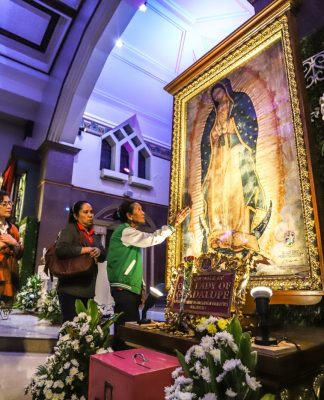WITH nostalgia in their eyes, 12 former UST internees of the Santo Tomas internment camp during the Second World War went back to the University in a sentimental homecoming last Feb. 3 during the 60th anniversary of the liberation of Manila..
Accompanied by their families, the internees, most of them still children during the Japanese occupation, shared their experiences, recalling how it was easier for children to get by then than it was for adults.
“We stayed in UST for 37 months. For children, we were with our friends day and night and it was a lot easier on us than it was for the adults because they had a lot of worries,” said Sascha Jean Jansen during the colloquium.
Fr. Rector Tamerlane Lana, O.P. also emphasized the role of the University as witness to the difficulty faced by the internees.
“There was no doubt (that) the University became the first hand witness of the difficult ordeals the internees had to undergo brought about by the atrocities of war even as the Dominican Fathers and the UST officials tried their best with prudence and tenacity to relate with the Japanese camp authorities to protect and serve both the interest of the University and the internees,” Fr. Lana said.
United States Ambassador to the Philippines Francis Ricciardone reaffirmed the close relations between the Philippines and the US.
“As we stood together 60 years ago, so we must remain firm today against the threats to freedom in our shrinking world,” he said. “And we must work together to unleash the talents, energies and ambitions of all people, not least through (UST’s) mission of education.”
The U.S. Ambassador lauded the University for hosting the celebration, and added that it “helps the people get through the dark times in their own lives.”
Meanwhile, Senator Richard Gordon, World War II (WWII) 60th Anniversary Philippine Organizing Committee co-chairman, emphasized that the celebration “reacquaints the public with the significance of the war as a shaping event of the 20th century.”
“I think this is a great night of history, and certainly we are commemorating a very powerful moment in Filipino and American history,” said Gordon, who said his grandfather was also interned in UST.
The UST Museum of Arts and Sciences later unveiled an exhibit of World War II memorabilia including photographs and letters of the internees.
The internees and their families also checked on all of the 3,500 names of those who were interned in a long role set up by the Museum. The internees said many of the names had died long ago.
The UST celebration commemorated the release on Jan. 28, 1945 of around 3,500 American and allied captives from the University, which served as an internment camp during the Japanese occupation..
Earlier, American journalist Hampton Sides discussed his book, Ghost Soldiers: Forgotten Epic Story of World War II’s Most Dramatic Mission, on the 375 American Rangers and Filipino guerillas who rescued more than 500 prisoners of war (POW) in 1945 from the Japanese prison camp in Cabanatuan.
Sides’s book also recounts the ordeal and sacrifices of the last POWs who survived the 1942 Bataan Death March.
“Those remaining (POWs) called themselves “ghost soldiers” because they felt they were forgotten by their own country and by the land of the living,” Sides said in his lecture last Feb. 1 at the Faculty of Arts and Letters audio-visual room.
In addition, the book described how the Americans and Filipinos helped each other in their rescue mission.
“The rescue at Cabanatuan represents not only a high-water mark in the history of WWII in the pacific, but also a high mark in the good relations between the United States and the Philippines,” Sides said.
Aside from the stories of heroism, the book also contained photographs provided by a former UST internee during the Japanese occupation. John Rheeno T. Cabangcalan and Lady Camille L. de Guia with reports from Dino Paul Maragay














